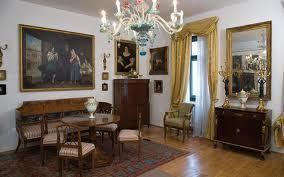Established 2003 Director Veljko Marton Phone +385 1 3670 600 | Website www.muzej-marton.hr Founded 2003 | |
 | ||
Similar Marton Museum of Country B, Samoborski muzej, Hrvatski športski muzej, Hrvatski muzej arhitektur, Glyptotheque | ||
Marton museum art nouveau
The Marton Museum is Croatia's first private museum and specializes in 18th and 19th century European applied art. The Marton Museum derives its name from its original founder, Mr Veljko Marton, whose collection is featured within its walls.
Contents
Marton museum
History
Veljko Marton held the first exhibit of his personal art collection at Zagreb's Museum of Arts and Crafts in the fall of 2002. In the end over 700 works were presented to the public as part of the show. The exhibition was deemed a success and subsequently led to the idea of opening up a permanent museum to house the collection. The resulting Marton Museum subsequently opened its doors in Samobor, a town located on the outskirts of Zagreb. The official opening was held on May 18, 2003, a date which coincided with that year's International Museum Day.
The museum has held numerous exhibitions throughout Croatia and has also exhibited internationally. In June 2008, the Marton Museum held its first exhibition on British soil at the Croatian Embassy in downtown London. In February 2009 the Marton Museum went on to exhibit selected pieces at the Sèvres - Cité de la céramique on the outskirts of Paris. In the summer of 2010 the Marton Museum organized its first exhibit in Austria at Vienna's Liechtenstein Museum. That same winter the museum organized its first Italian exhibit in Venice at the Pinacoteca Querini Stampalia.
In early 2011 the Marton Museum announced that it was expanding to the city of Zagreb, with its new home being the historic Kulmer Palace in the city's Gornji Grad – Medveščak quarter (Old Town). The grand opening was held on March 18, 2011. While the move greatly expanded the museum's existing exhibition space, it was too much too soon.
Although it opened to much fanfare, the Marton Museum's time at its new location was short lived due to disastrous management on the part of its founder, Veljko Marton. Employees soon began leaving the institution as doubts about its leadership became apparent. Eventually, the number of visitors dropped to a level too low to sustain operations and the new location was finally closed ignominiously after incurring too much debt after barely a year in its new location.The museum has now been relegated to its original home in Samobor, Croatia, with minimal staff and services. There are no official opening hours, the exhibitions do not even have signs and the website has been known to shut down for no given reason.
Local Croatian politicians have made a point of visiting the struggling institution, along with a number of foreign dignitaries from countries including Hungary, Iceland, Moldova and Serbia, among others.
The Collection
The museum's collection counts a number of silver and glass pieces, along with various paintings and furniture pieces, yet it perhaps bears mention that the museum is particularly known for its European porcelain. The Marton Collection features pieces from many well known and historic manufacturers including Meissen and Sèvres, among others. Vienna porcelain is particularly well represented, with numerous pieces ranging from the early Du Paquier period to the later Sorgenthal period. The depth of the collection in this area is such that one can easily trace the evolution of tastes and decorative styles of the aristocracy who bought these pieces over the decades, from early Chinese influenced floral patterns to later painted depictions of European landscapes and gilded neoclassical motifs.
Many of the porcelain pieces enjoy a royal provenance and are directly related to the European regency who could afford these luxuries at the time. For example, among the many pieces of historic Russian porcelain contained within the collection, there exist plates that were commissioned by Catherine the Great for both the St. Alexander Nevsky and St. Vladimir Order service, another plate that was made for the wedding of Duke Constantin Nikolayevich (son of Tsar Nicholas I), as well a glass cooler that was made for the Grand Duchess of Catherine Pavlova as part of her dowry for her marriage to Prince Peter Friedrich Georg Oldenburg, among others.
A number of pieces that were originally part of the collection have been sold unfortunately to pay off debts incurred by Mr. Marton. Other pieces are often out on loan to generate much needed revenue for this loss-making institution. There is much speculation as to whether the Marton Museum will survive the eventual departure of its founder.
